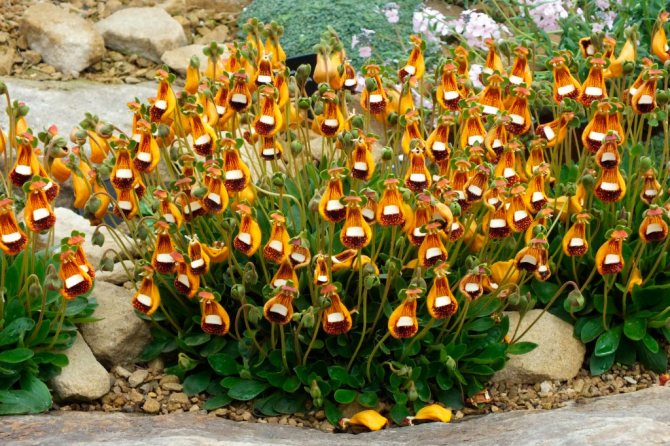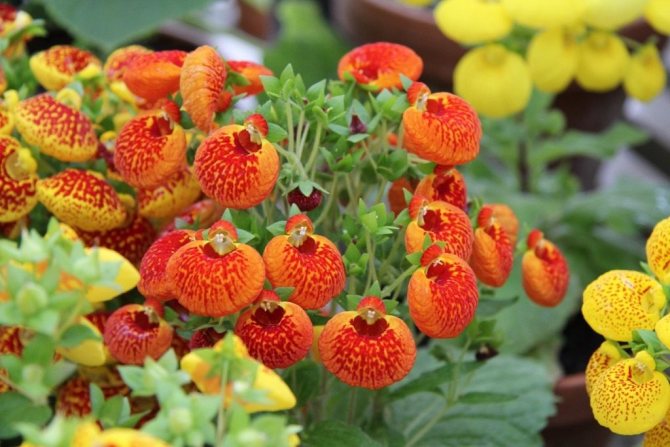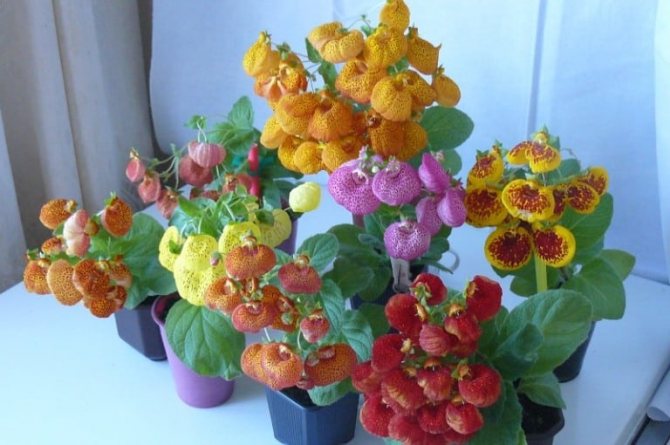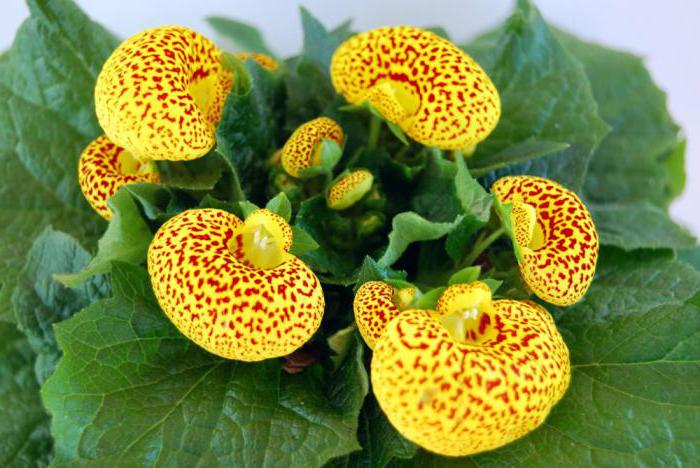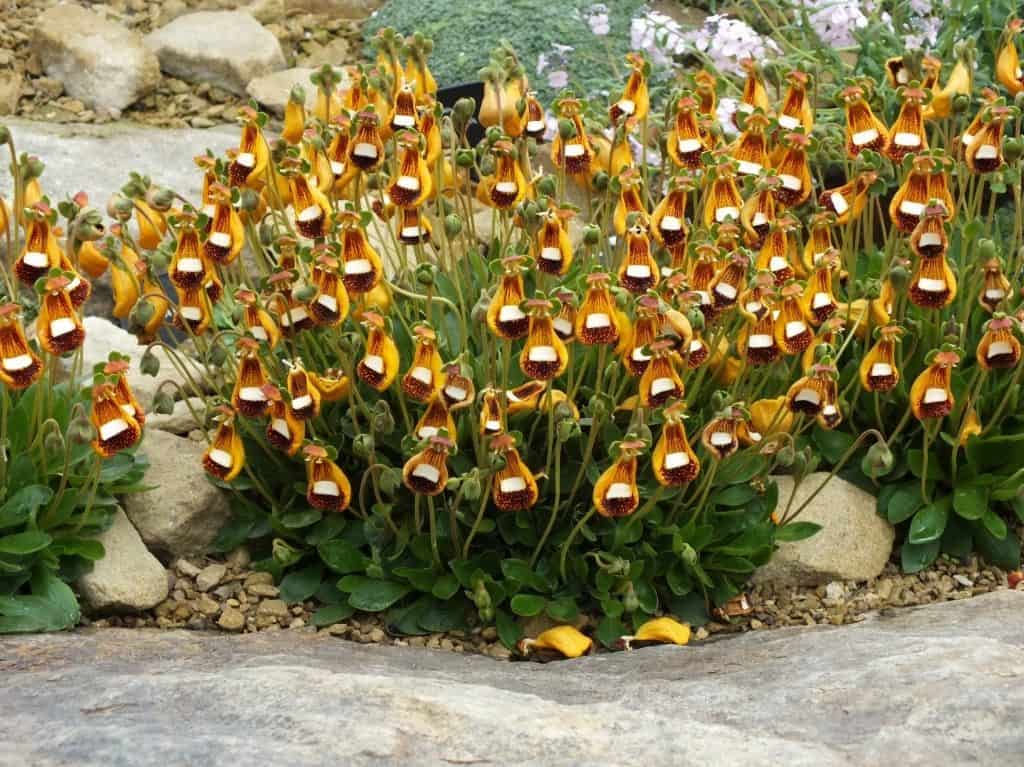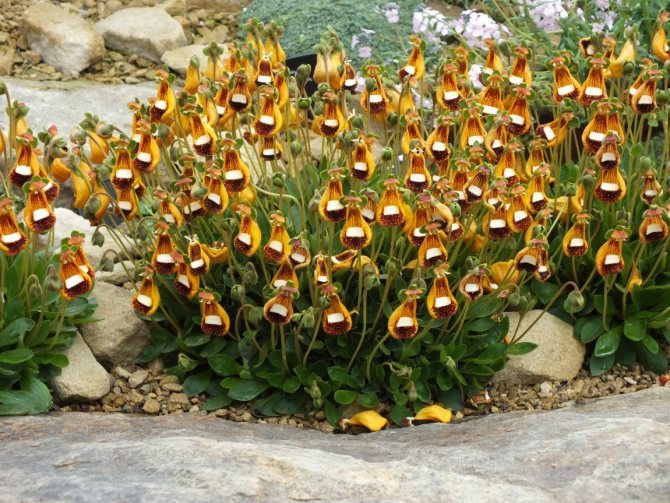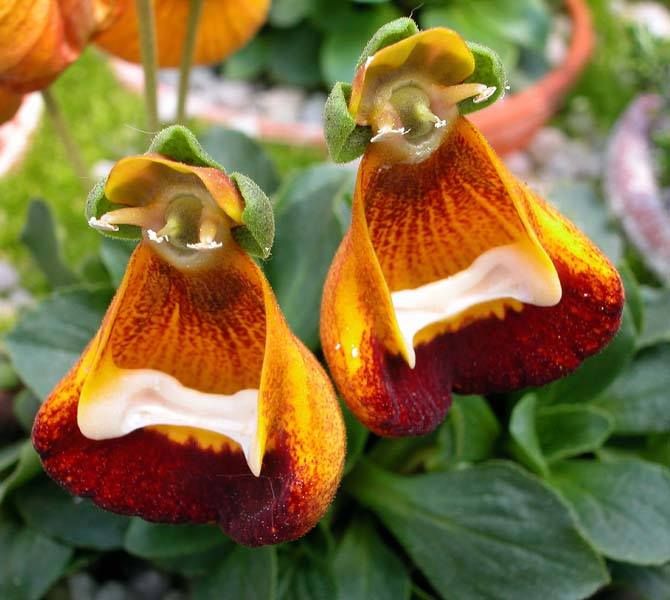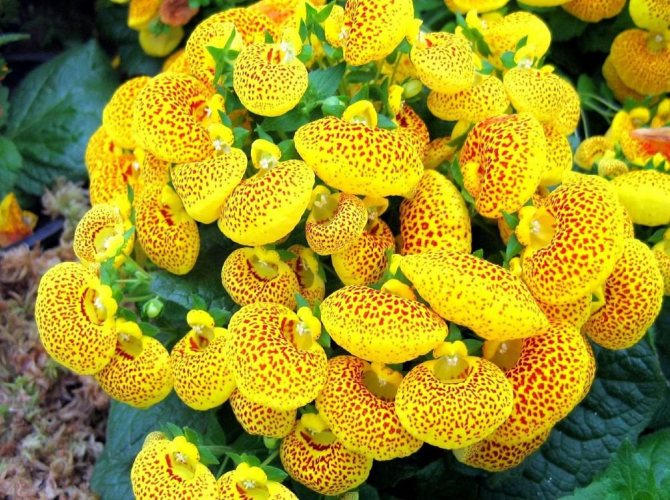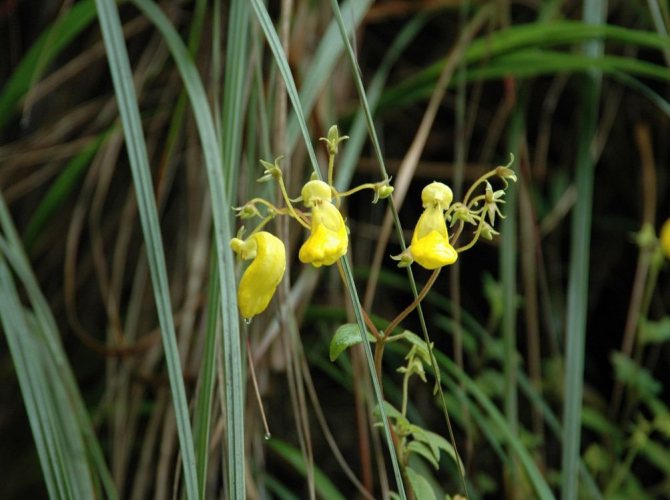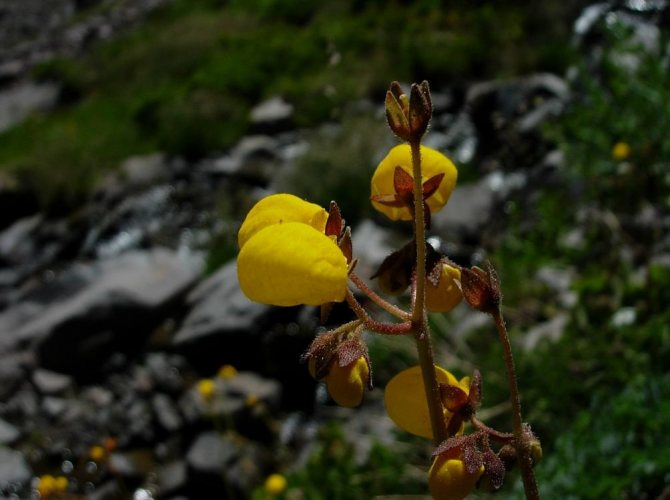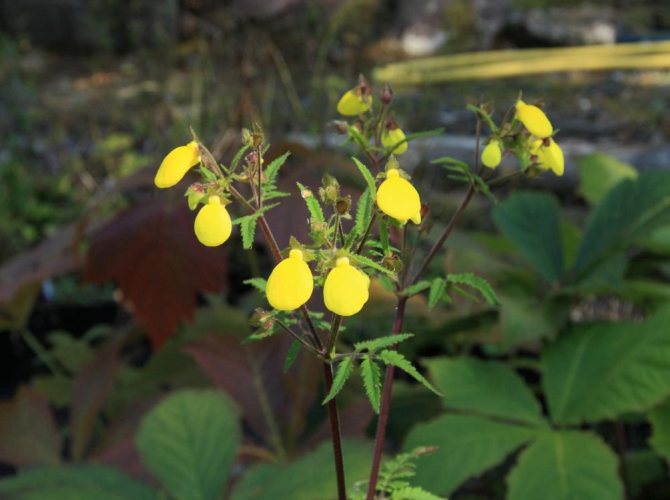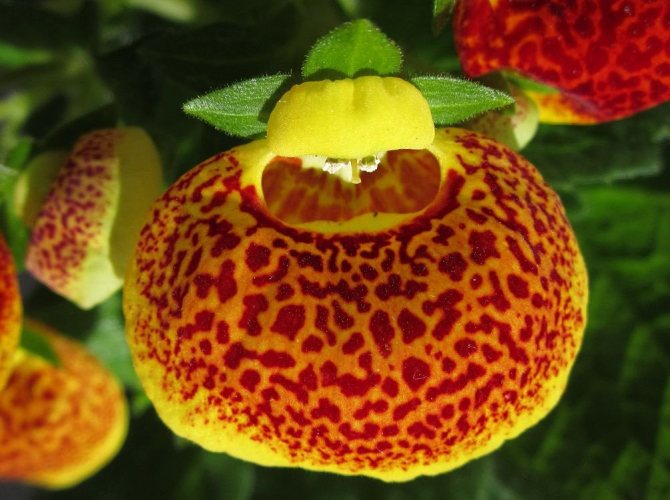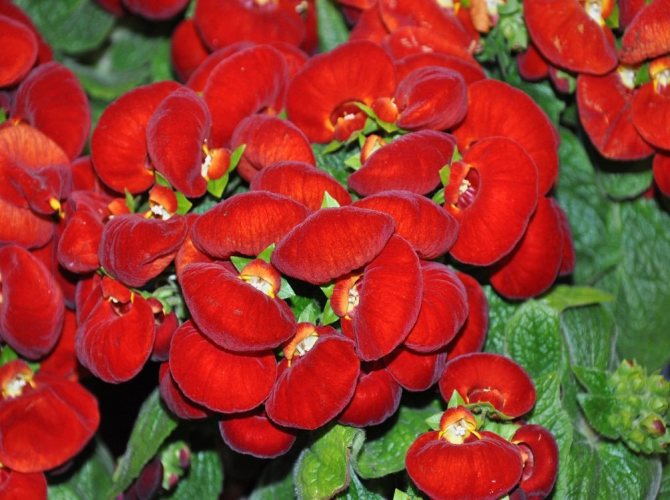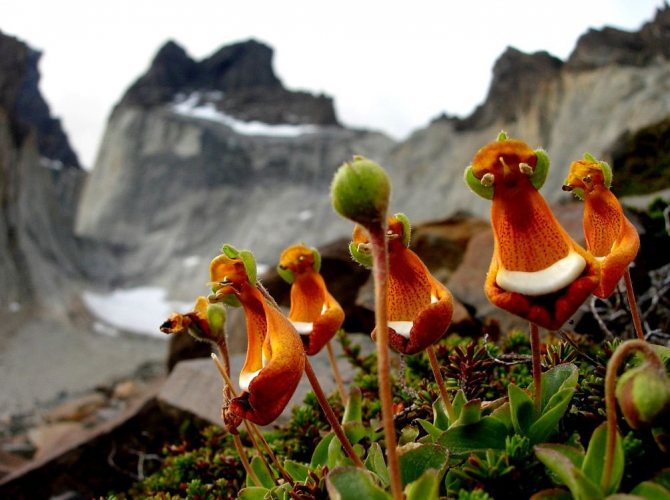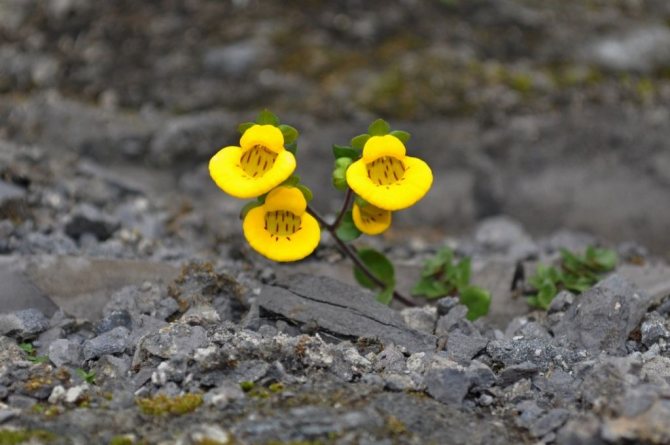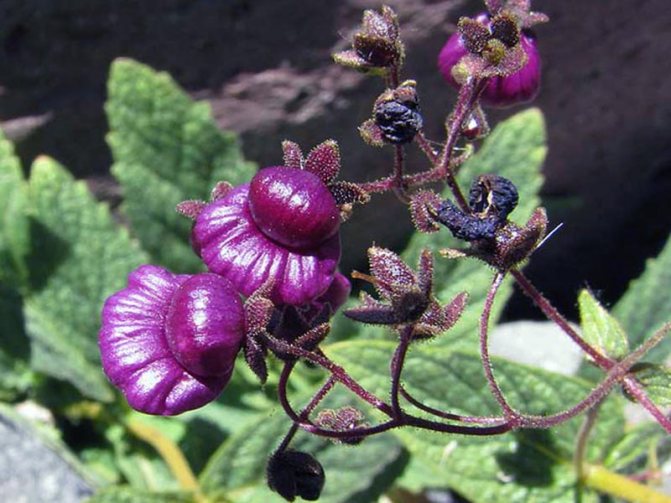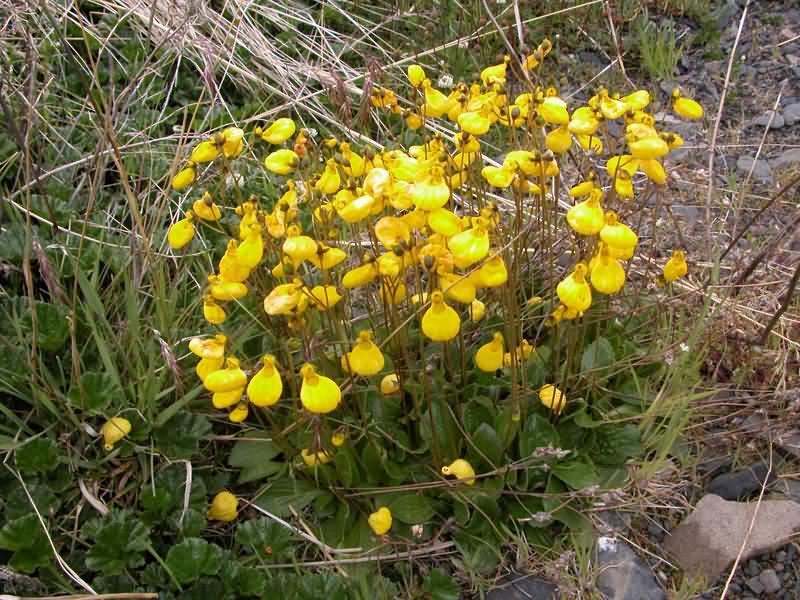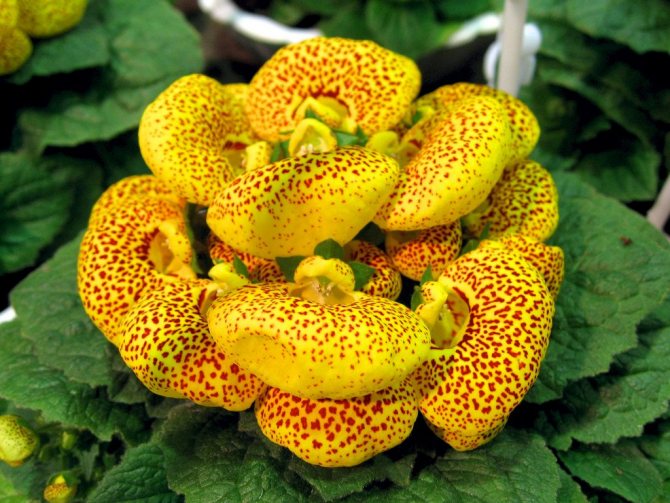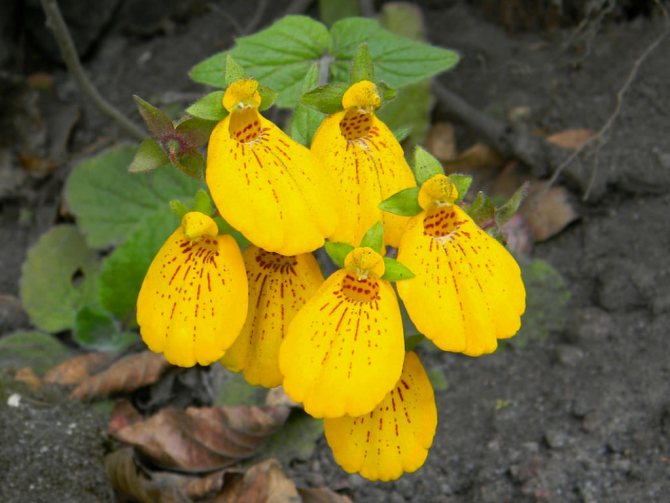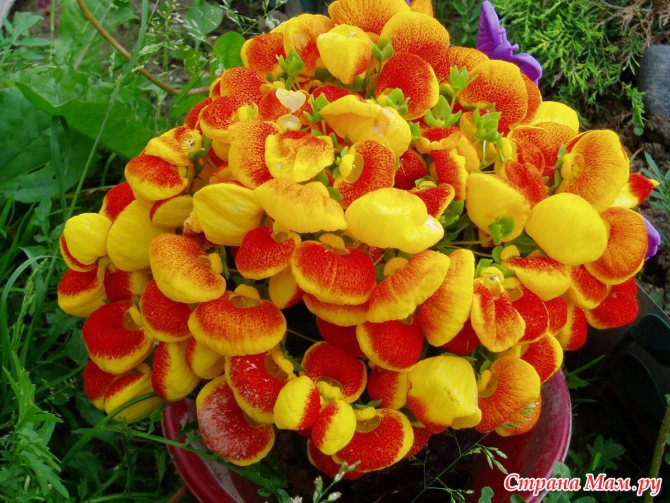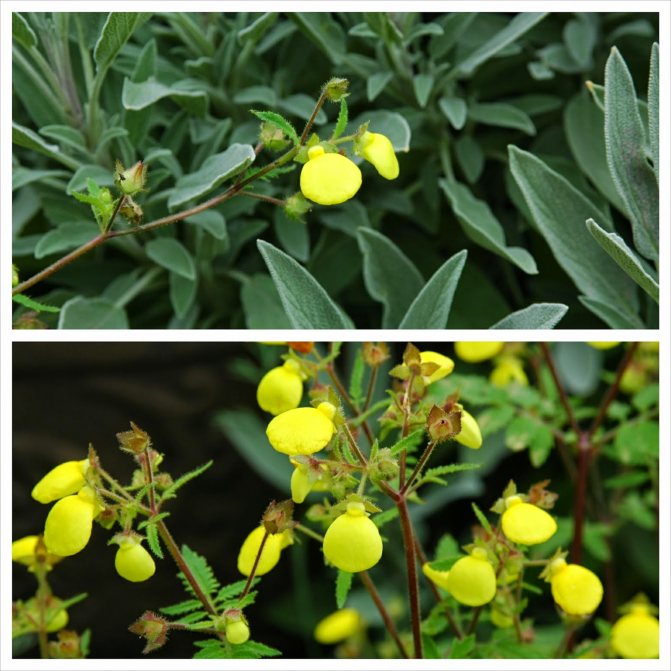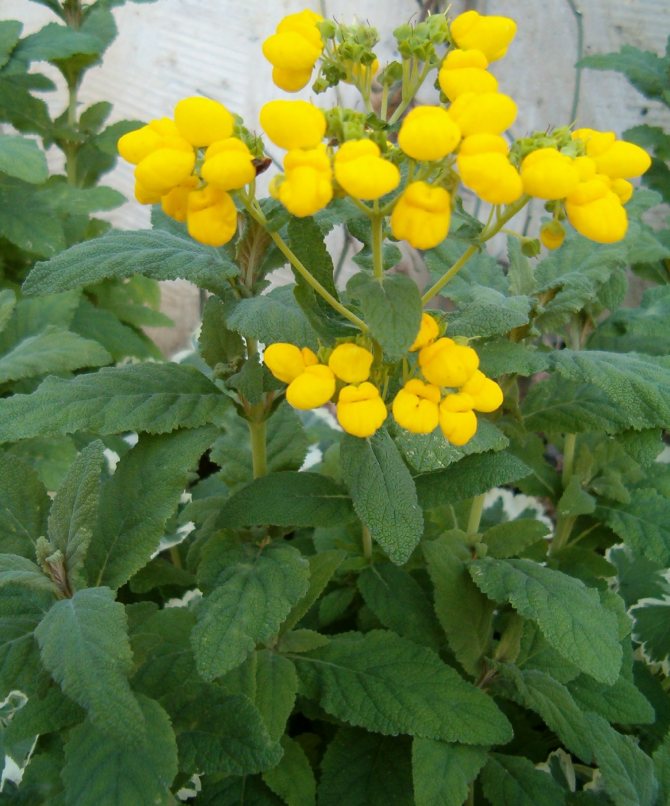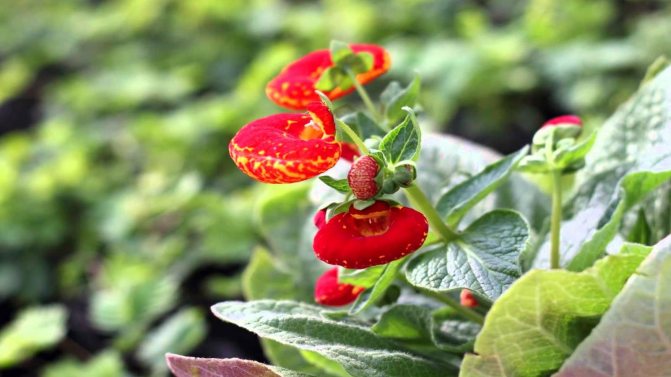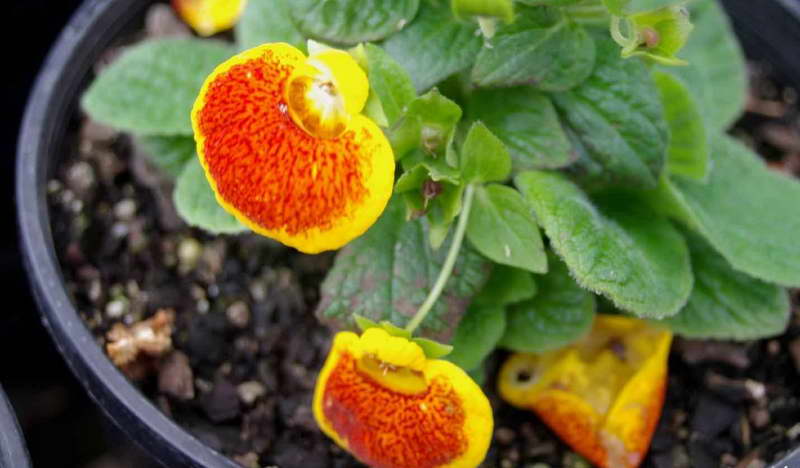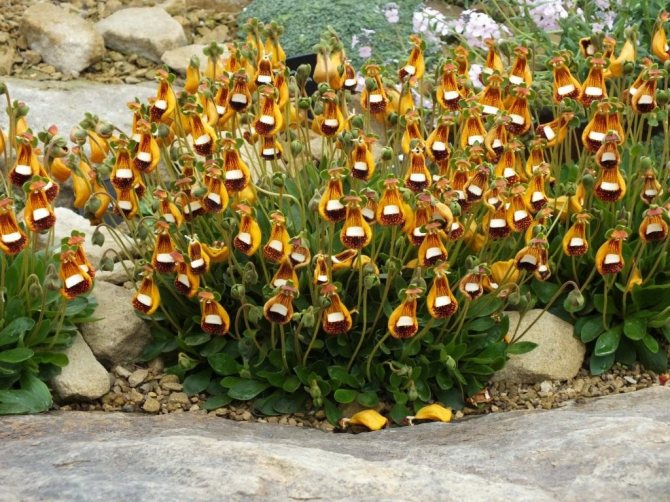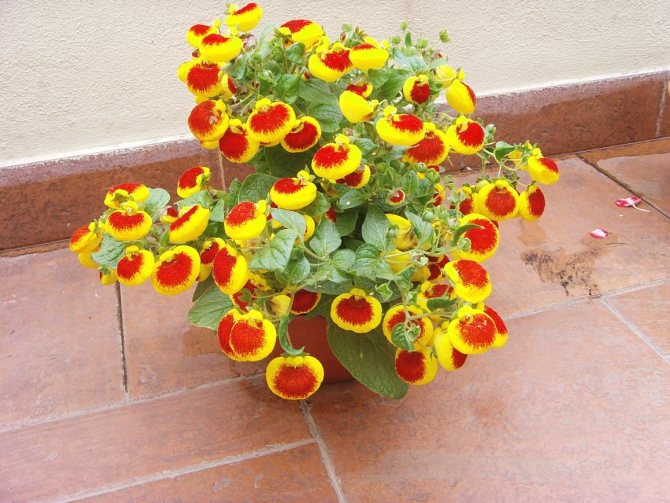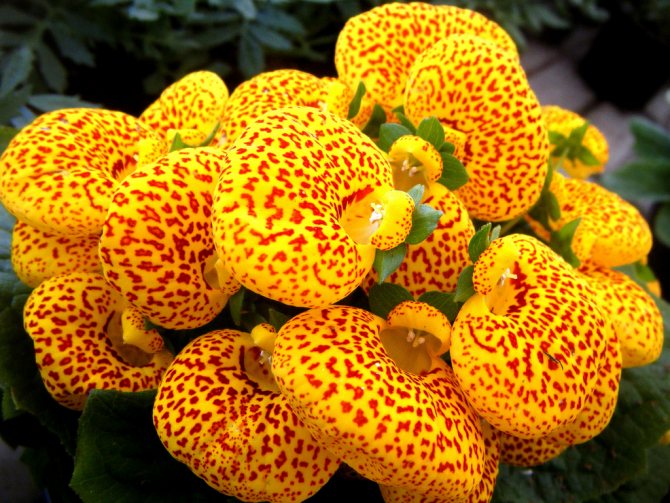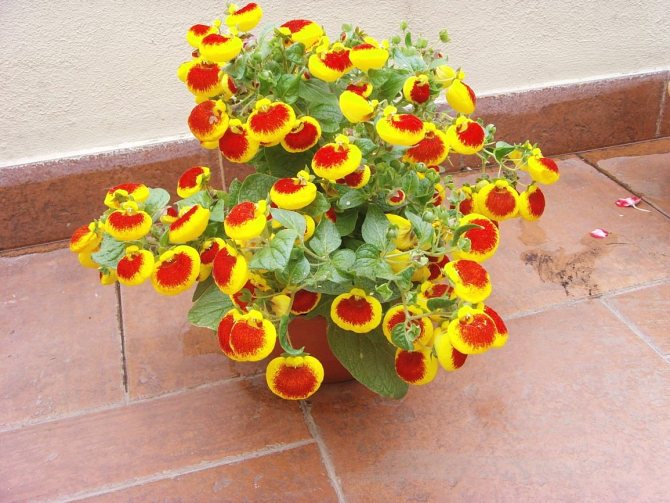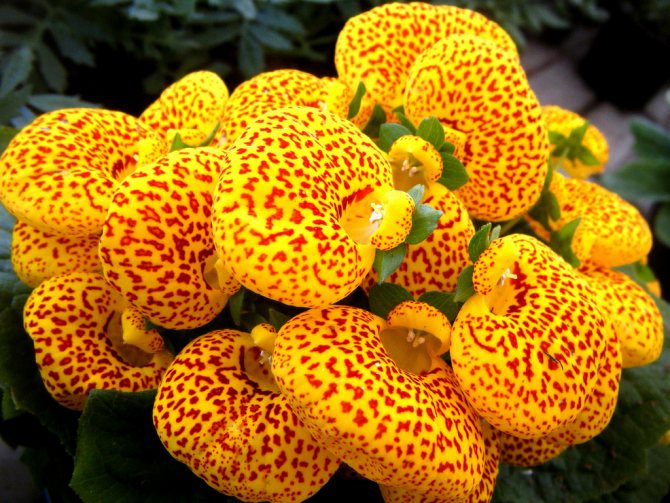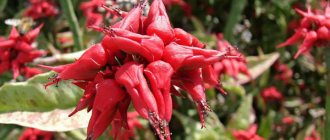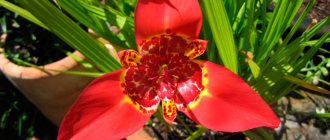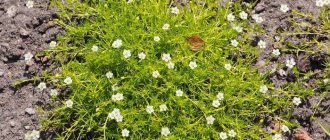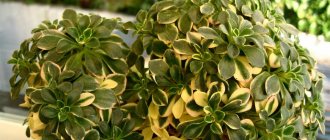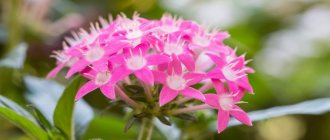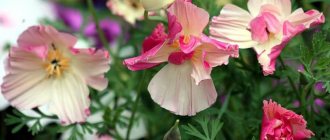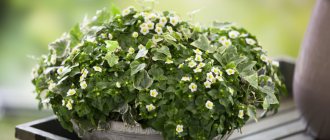The calceolaria plant belongs to the norichnik family, despite the fact that representatives of science from England attribute this subspecies to a separate plant family. The genus has about 400 varieties of the plant, which has found distribution in the South American continent and in the central part of America.
The flower is awarded with a name that means shoe. The genus includes plants of herbaceous type, semi-shrub and shrub. They also include perennials, annuals and biennials.
At home, a calceolaria flower can grow as an indoor flower, since it involves growing like a herbaceous plant.
Lady's slipper
This is exactly what the calceolaria uniflora is called. An unusual mountain lover appeared in the eyes of botanists in South America, on Tierra del Fuego. It was brought from America to England, and then the exotic beauty spread to homes throughout Europe.
The bush is very small, the specificity of the mountainous area did not allow it to grow more than 10 cm in height. Leaves are oval, green, collected in a socket.
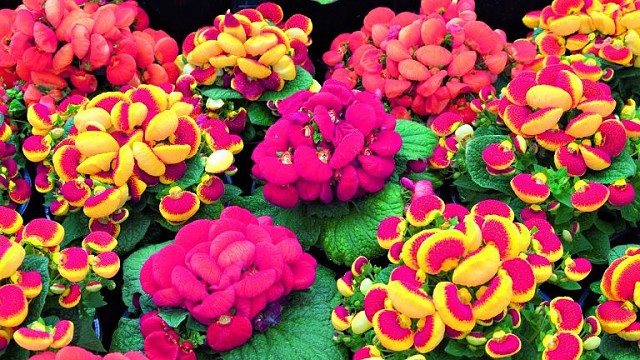
Bright and unusual calceolaria flowers
Flowers 2.5 cm long grow on long shoots. The inflorescence consists of two convex petals. The upper petal is very small and inconspicuous, while the lower one is elongated and rounded.
At the base of the petals, the core is decorated with 2-3 stamens. The color is yellow, with red spots and dots. Mountain exotic blooms in July, about five weeks.
It's important to know! It surprises with frost resistance (up to -23 ° C), inherent in it by nature.
Botanical description
Calceolaria is a perennial that is grown as an annual or biennial plant in temperate climates. The height of the shoots is 10-50 cm. The root system has a fibrous structure. Soft branched shoots are located above the ground. Erect or lodging stems and foliage are covered with thick pile.
The petiolate leaves of a lanceolate or oval shape have wavy edges and a corrugated surface. The length of the leaf is 5-10 cm. Most of the soft, pleasant to the touch leaves are concentrated near the ground.
Flowering begins approximately 5 months after planting and lasts up to 5 weeks. This feature allows you to guess the appearance of flowers for a specific celebration or date. One plant can bloom up to 50 buds. They are collected on one inflorescence or on several smaller ones. The inflorescence is racemose. Flowers have an unusual structure. The two-lipped corolla at the bottom has a large pouting lip, and on top is a much smaller, spherical lip. The flower diameter ranges from 25 to 60 mm. The color can be yellow-orange, red, brown. Often white or pink spots are located on the surface of the petals. In the center there are 2-3 stamens and an ovary.
After pollination, the fruit ripens - a dry, oblong-shaped seed capsule. Inside there are many small dusty brown seeds.
Popular types of calceolaria for growing in the garden
Catharanthus flower: home care and breeding methods
Calceolaria is grown in the garden as an annual flower. After flowering, hot weather destroys the decorative effect of the bush, so every year gardeners renew their blooming flower bed from these unusual flowers.
Garden varieties are diverse, have a different color and shape of inflorescences. Unlike mountain one-flowered calceolaria, garden ones can grow up to 50 cm in length, and bush in width by 25-35 cm.
The most common varieties of calceolaria are:
- Calceolaria Mexicana (Calceolaria Mexicana). The bright inhabitant of the Mexican mountains is thermophilic, grows up to 25 cm in height. Oval leaves covered with pile are placed on branched shoots. Yellow flowers are double-lipped up to 5 cm in diameter, placed at the ends of the shoots. Loves shaded, wet places and protection from the wind. Abundant flowering occurs in May-June and lasts up to 3 weeks.
- Calceolaria Wrinkled, or Whole-leaved (Calceolaria Rugosa, Calceolaria Integrifolia). The Chilean beauty produces branchy shoots up to 25 cm. Leaves are oval, pointed, with clear veins. Flowers up to 2.5 cm in diameter, pure yellow, densely dotted at the tops of the stems. Flowering lasts all summer until the very cold.
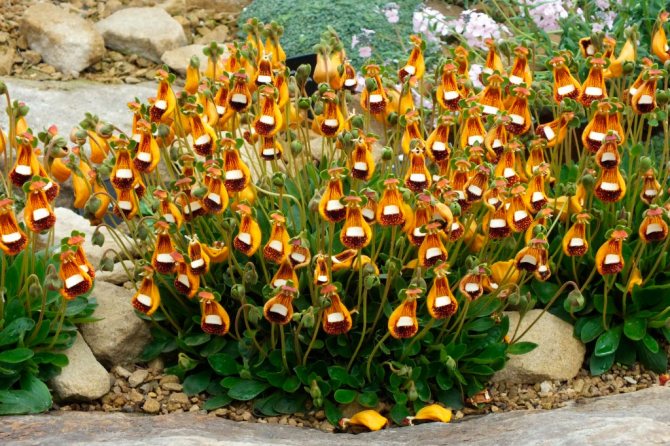

Calceolaria one-flowered or lady's slipper
- Calceolaria Purpurea (Calceolaria Purpureа). The bush grows up to 50 cm in height and is distinguished by its beautiful color of petals and shoots - dark purple. The leaves also have a purple tint, dark, with jagged edges. The inflorescence is two-lipped - the lower petal is swollen and looks like a shell, and the upper purple ball lies on top of the second. The bright color does not allow you to pass by such a spectacular bush in the garden.
- Calceolaria Tenella. Bush no more than 8 cm high with small dark leaves collected in a socket. Flowers are painted in yellow-gold color with red dots or stripes.
- Calceolaria Crenatiflora. The miniature representative of Chile grows up to 10 cm in height. Leaves are ground cover, crenate along the edge. Flowers up to 2.5 cm in length, yellow with purple spots, two-lipped. Blooms in July, single flowers or collected in bunches of 2-5 pcs.
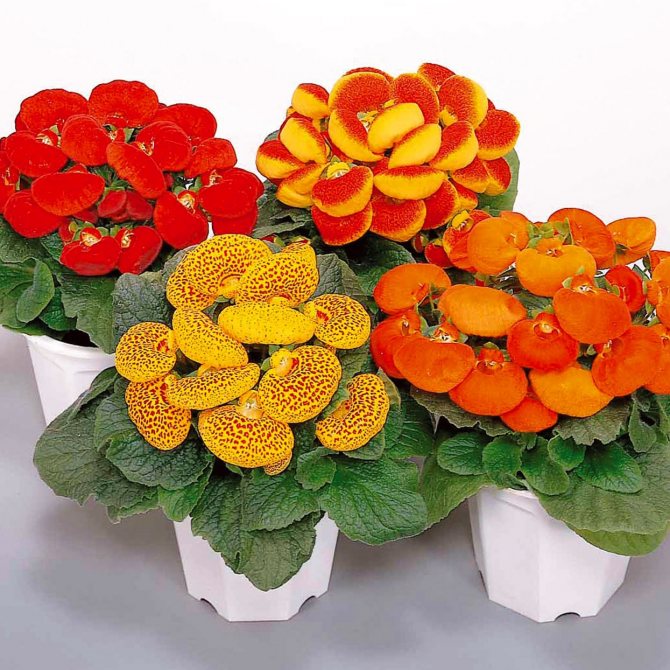

Hybrid varieties are distinguished by contrasting colors
How to transplant correctly?
Calceolaria is an indoor flower, after purchase it needs a transplant, because a technical pot needs to be replaced with a decorative one. The step-by-step transplant process is as follows:
- a sufficient amount of drainage is poured into the prepared pot;
- a bush with a lump of earth is carefully rolled over;
- to close unwanted pits, heather soil or geranium soil is poured.
For a comfortable stay of the plant in the ground, leaf and sod components, peat and sand are added to the soil.
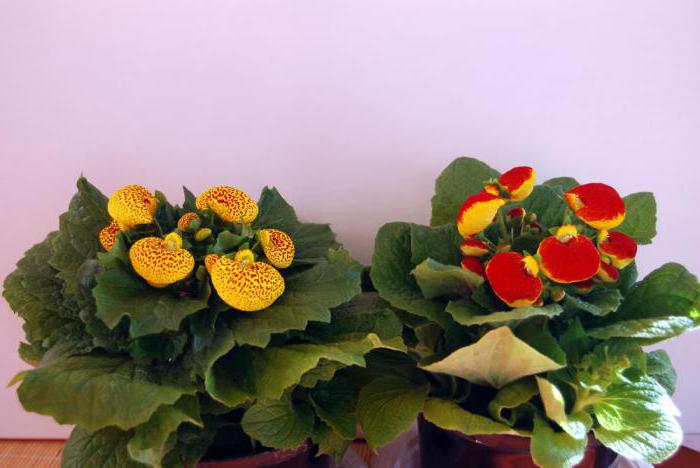

Calceolaria: planting and care
A lover of moisture is demanding on the composition of the soil, since its roots can rot. The soil should be as light and loose as possible. A good composition would be a mixture of:
- peat;
- leafy land;
- deciduous humus;
- sand;
- fern roots;
- wood ash;
- crushed activated carbon.
Hippeastrum flower - home and outdoor care
A small bush is planted by transshipment with minimal damage to the roots in small pots (no more than 1.2 liters). The pot must have a good drainage layer. The root collar should not go deep into the ground.
After planting, you need to create comfortable conditions for abundant flowering. The foundation of calceolaria care is low temperature, high humidity and abundant watering.
The temperature is not higher than 23 ° С in summer and the obligatory daily temperature drop is 7 degrees. In the winter period of rest and during flowering, the optimum temperature is 14-17 ° C.
It's important to know! If the temperature regime is not observed, the plant loses its decorative effect, can shed its buds and grow old faster.
The humidity should be high. Moreover, the higher the temperature, the higher the humidity should be. On hot summer days, a pot of calceolaria should be placed on a pallet with wet expanded clay and sprayed 2-3 times a day.Spraying should be from a fine spray bottle, as drops of water on the leaves lead to their deterioration.
Watering is needed frequent, but not plentiful. The soil in the pot should be moist, but not wet and free from stagnation in the root ball. Excess liquid residues must be removed from the sump.
It's important to know! Water for spraying and irrigation should be warm (25-28 ° C), free of lime and chlorine.
The lighting is bright, but diffuse. West and east windows will provide optimal lighting. In winter, backlighting is needed so that the daylight hours are at least 8 hours.
Starting from waking up and throughout the entire flowering period, calceolaria needs constant bait. Mineral fertilizers are applied 2-3 times a month.
Forming a bush is part of the grooming. Lateral shoots are removed so that the flowering is stronger, and the bush does not waddle to one side.
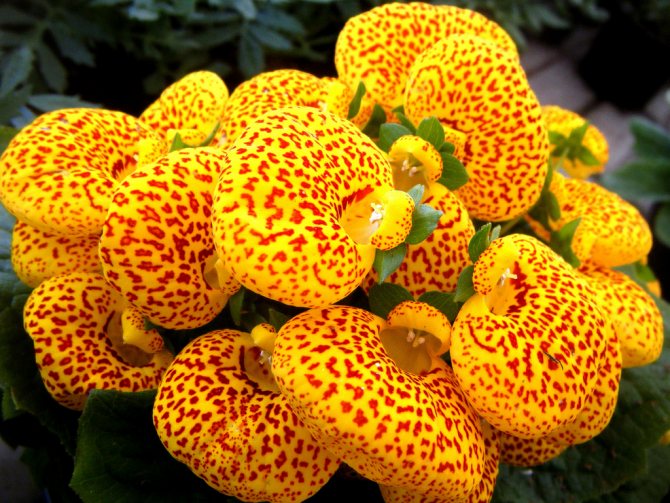

Pruning lateral shoots makes it possible to obtain abundant flowering with larger flowers
Reproduction of calceolaria
The plant reproduces in two ways:
- seeds;
- by cuttings.
Growing from seeds
The timing of sowing seeds indoors depends on when you want the flower to bloom. For spring flowering, planting should be done in June, and for autumn flowering - in March.
For sowing seeds, you need to prepare peat soil mixed with sand (7: 1). However, calceolaria does not like sour peat, so it is recommended to add ground chalk to it. About twenty grams of chalk is added to one kilogram of peat. The resulting soil must be well calcined before use.
Calceolaria seeds are very small, so they are simply scattered over the soil surface. You do not need to sprinkle them with anything. It is recommended to put a wet piece of paper on top, moistening it regularly. You need to keep crops in a warm room with a temperature of at least + 18C.
The first seedlings should appear in about two weeks. They should be watered between rows, gently pouring water in a thin stream. As soon as two true leaves appear on the seedlings, they must be dived. In order for the processes to take root well, they can be covered with plastic or glass. The seedlings need to be ventilated daily, especially after condensation has accumulated on the glass. Peat should always be moist.
Two months later, the second picking of seedlings into pots with a diameter of 9-11 cm is carried out. Immediately after transplanting, the plant is pinched. Only two or three pairs of leaves should remain on the bush. After a while, young shoots will begin to appear.
Already matured plants are transplanted into flower pots. The soil for this must be heavier and more nutritious. To prepare it, you will need to prepare:
- turf - 2 parts;
- humus - 2 parts;
- peat - 2 parts;
- sand - 1 part.
Calceolaria will bloom, subject to all the rules of cultivation, in 8-10 months from the moment of sowing the seeds.
Cuttings
Cuttings cut after flowering can be tried to root. The optimal months for cuttings are February, March and August. The shoots are dipped in a special rooting powder and planted in a nutritious soil mixture. For the first time, it is recommended to cover them on top with a plastic bag or glass container. In the new place, the cuttings will take root for about two months. To make the calceolaria bush fluffy, several scraps are planted in one pot.
Growing
Gloriosa flower: home care and planting examples
Calceolaria from seeds at home propagates more easily than by cuttings. Before sowing, it must be borne in mind that the period from breeding to flowering is from 5 to 10 months.
It's important to know! It is best to sow seeds on peat, without sprinkling on top. For an optimal humid environment, the box is covered with glass or foil.
You need to constantly monitor that the soil is moist.When a rosette of leaves appears, calceolaria is dived into 7 cm pots. After that, you will need another 2-4 transplants with pinching the rosette for the formation of side shoots and bushiness.
The last transplant is needed already in the nutrient soil. Seedlings are planted using the transshipment method. You need to take care of young growth as carefully as for an adult flower.
Reproduction
Most often, calceolaria is propagated by seeds. They can be purchased from the store or obtained from your own plant. From the seeds of one plant, depending on the conditions of detention, stunted or tall specimens can grow. Fresh seeds germinate very well. You can sow calceolaria at any time of the year, focusing on the estimated flowering date.
Crops are made in shallow containers with light peat soil. A small amount of sand and chalk can be added to the soil. The ground is carefully leveled, sprayed with a spray bottle and the seeds are spread on the surface. The container must be covered with foil or glass and placed in a bright room with an air temperature of + 18… + 20 ° C.
Seedlings appear in 5-7 days. When 2-4 true leaves appear on tiny seedlings, the first pick is carried out (the plants are about 1.5 weeks old). After 1.5 months, the plants are dived again in separate pots or plastic cups. Each pick significantly accelerates growth, the development of seedlings is much faster than that of unpicked specimens. After another 1.5-2 months, the grown calceolaria are planted in pots up to 11 cm in diameter and grown as adult plants.
After the end of the flowering period, many lateral processes are formed on the bush. A stalk 5-7 cm long can be cut and rooted. Rooting is carried out in loose peat soil. High humidity must be maintained. To do this, use a film or plastic cap. The process takes 2-3 weeks, after which the seedlings can be distributed in separate pots and the shelter removed.
When and how to plant calceolaria outdoors
In spring, when the temperature at night is not lower than 13 and not higher than 18 degrees, calceolaria can be planted in open ground as a garden plant. It will take root well in soil that has been fertilized with compost in advance.
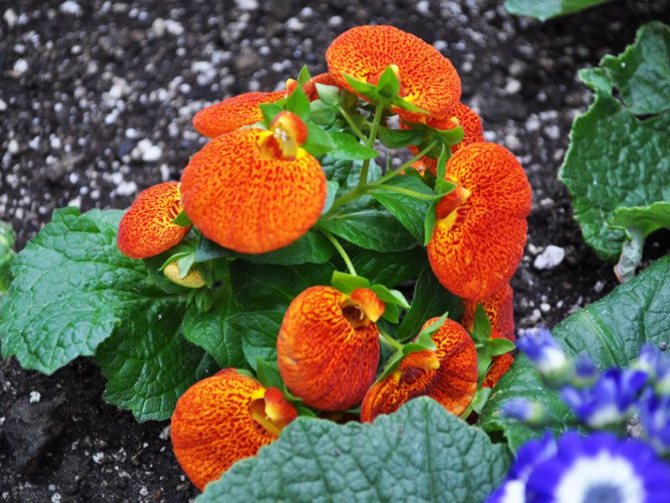

Garden cultivation of calceolaria is suitable for regions with mild climates
During the entire flowering period, the temperature conditions will contribute to the well-being of the flower. Watering should not be abundant.
Fertilizing with mineral fertilizers is needed throughout the flowering period twice a month. Planting and caring for calceolaria at home, grown from seeds immediately in the open field, does not differ from transplanting. The main thing is not to let the seeds rot in the soil and to provide sufficient lighting.
How to care for calceolaria correctly
Such a plant simply needs diffused light, and it does not tolerate the direct rays of the sun, from which it must be shaded. Grows well on window sills located on the west or east window. If calceolaria is placed on a southern windowsill, then it needs good shading, which can be made from paper or a translucent material (for example, tulle, gauze, tracing paper, and so on). Also feels great on the northern windowsill. When the plant begins to bloom, it will not need very much shading. In the autumn-winter period, it is recommended to supplement the flower with fluorescent lamps.
Calceolaria: care in winter
Calceolaria is a flower that is most often grown as an annual, as it dies with an increase in temperature after flowering. If there is a desire to leave this wonderful exotic for the next year, after flowering, you need to dig up the calceolaria and plant it in a pot.
A faded bush hibernates for several months, during this period, care for calceolaria is as follows:
- it is necessary to cut off all the shoots and leaves of the plant;
- put the pot in a cool and dark place (+ 5-7 ° C);
- watering should be reduced to a minimum, but without the risk of drying out the earth;
When the first shoots appear, full care is restored:
- the pot is placed in a sunny place;
- watering becomes regular;
- a high level of humidity is maintained.
It's important to know! The flower blooms earlier in the second year, flowering lasts less.
Moisture and fertilization
Domestic calceolaria flowers prefer high atmospheric humidity. But spraying is not suitable. To increase the humidity, the pot is placed in a pan with a humidified drain. It can be expanded clay gravel, pebbles. The container with the flower does not touch the water. The bush can be grown in a flower pot, filling the lower space with moist peat.
Fertilizers are applied two weeks after planting. Then fertilize until the flowers appear once every two weeks. In this case, mineral compositions are used.
After the bush has faded, it can be cut off and transferred to a dark, cold room for two months. Watering at this time is rare, so that the earth does not dry out completely. When new growth grows, the plant is returned to its usual bright place. There it will bloom earlier than the specimens derived from seeds. But decorativeness with this method of cultivation is lost.
Decorativeness is also lost over time, for this reason it is better to change calceolaria to new specimens, and not to use transplants.
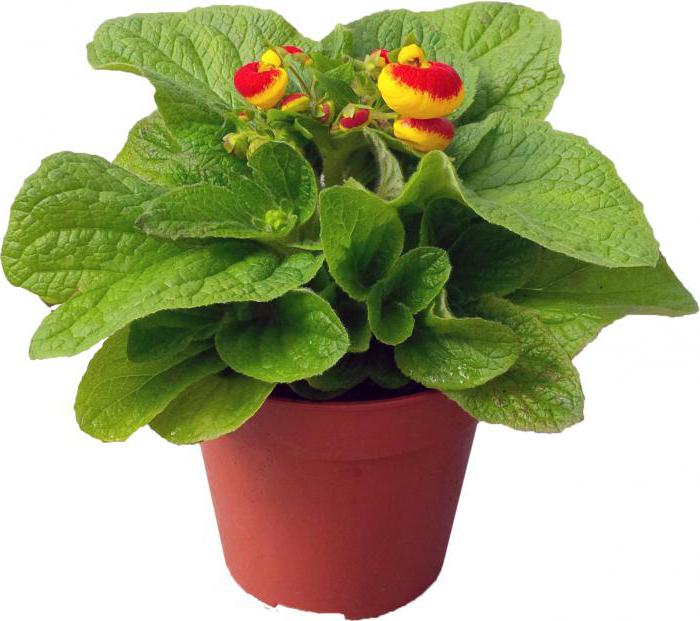

Potential pests and diseases
The most common pests on calceolaria leaves are aphids and whiteflies. If the population of pests on leaf blades has just begun, it is better to remove them manually. If there is an extensive damage to the foliage, insecticide treatment is inevitable.
After processing, it is necessary to analyze the care of the flower and find the cause of the pests so that they do not appear again on the delicate beauty.
Improper care will contribute to the emergence of disease. Excessive moisture and watering will cause gray rot. An excess of nitrogen in groundbaits will cause gray mold to appear.
It's important to know! Damaged areas of leaves and stems must be cut off with a sharp blade. The rest of the plant must be treated with antifungal agents.
Delicate calceolaria is not suitable for all growers. She is not aggressive, but loves care and proper care. In exchange, he presents his boyfriend with abundant and passionate flowering. Unusual flowers look very attractive on flower beds in the garden or on the windowsills of apartments. Funny aliens - this is how experienced breeders called their favorites.
Possible difficulties
Calceolaria flower, which is not so difficult to care for, usually grows without much difficulty. But some points are referred to as difficulties. Common problems:
- The leaves of the plant wither, the flower ages quickly. The reason for this is low air humidity and high room temperature.
- The plant needs to be replaced every year. For this, reproduction is used with the help of seeds or a new copy is acquired, and the old bush is eliminated.
- The bush can be affected by spider mites, whiteflies, scale insects, mealybugs. This is facilitated by the increased temperature during the cultivation of the calceolaria flower, the photo, the care of which we are considering.


